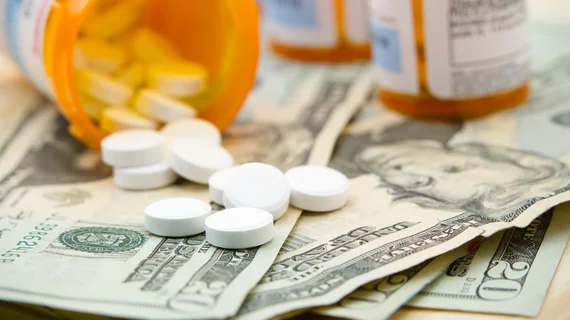Big Pharma’s industry payments to diagnostic radiologists have risen sharply since 2019
Payments from the pharmaceutical industry to diagnostic radiologists—for things such as consulting work or travel—have risen sharply in recent years, according to a new analysis published July 7.
Drugmaker Merk & Co. paid the largest amount to the specialty between 2017-2021 (at nearly $30 million), followed by device-maker Hologic and pharma firm Pfizer (each just shy of $15 million). Altogether, Big Pharma made more than 25,000 payments to members of the specialty during the five-year period, totaling $53 million, experts wrote in Current Problems in Diagnostic Radiology [1].
The specialty saw a fivefold decline in pharma payments in 2019. However, the numbers rebounded in 2020 and then doubled in 2021. Researchers also compared the numbers up against oncologists—a “more directly medicine-related field,” the authors noted—and found stark differences. Average pharmaceutical industry payments to diagnostic radiologists were 22 times greater in 2019 and 26 times greater in 2021 when compared to oncology.
“While physician-industry relations are important for improving patient care though innovation and education, studies have shown that financial payments can lead to inappropriate practice designs,” Sishir Doddi, with the University of Toledo College of Medicine, and co-author Sree Harsha Tirumani, MD, wrote Friday. “Diagnostic radiologists traditionally are not held under a lens for industry relations by patients due to the nature of their practice. However, with data on industry relations made public, scrutiny of all medical fields including radiology has increased.”
Researchers gathered their information from the Open Payments database, created as part of the Sunshine Act of 2010 and aimed at increasing transparency around providers’ industry relationships. Diagnostic radiologists collected a total of nearly 179,000 such payments between 2012 to 2020 at an average of $1,529 for cash contributions and $223 for in-kind items and services. Diagnostic radiologists received an average payment per transaction with pharmaceutical companies that was 10 times greater than oncologists each year of the study, peaking in 2021. Oncologists actually received more total payments each year up until 2019, followed by a steep decline in 2020 and 2021 while radiologists witnessed a steep increase. Some of the top reasons radiologists received a payment from the pharma industry included consulting fees ($44.2 million), “acquisitions” ($5.7 million), and for other services such as speaking ($1.7 million).
Meanwhile, non-pharmaceutical industry payments totaled $73 million across more than 69,000 transactions during the study period. Geographic location also appeared to impact these numbers. Radiologists located in the northeast and on the west coast were the largest recipients of such payments, possibly related to where vendors are based.
“It is generally hypothesized that company location determines industry payments to a geographic location,” the authors noted. “This can explain Massachusetts as the largest recipient given that the largest industry payer Merck Corporation is headquartered in the northeast of USA.”
Hologic also is based in Massachusetts, while Pfizer’s U.S. homebase is in New York. Others topping the list of industry payments made to radiologists included Medtronic, Penumbra, Kaleo, C.R. Bard, Ethicon, Siemens and GE Healthcare. You can find the full list, read the rest of the study, and browse previous Radiology Business coverage of industry payments to the specialty below.

